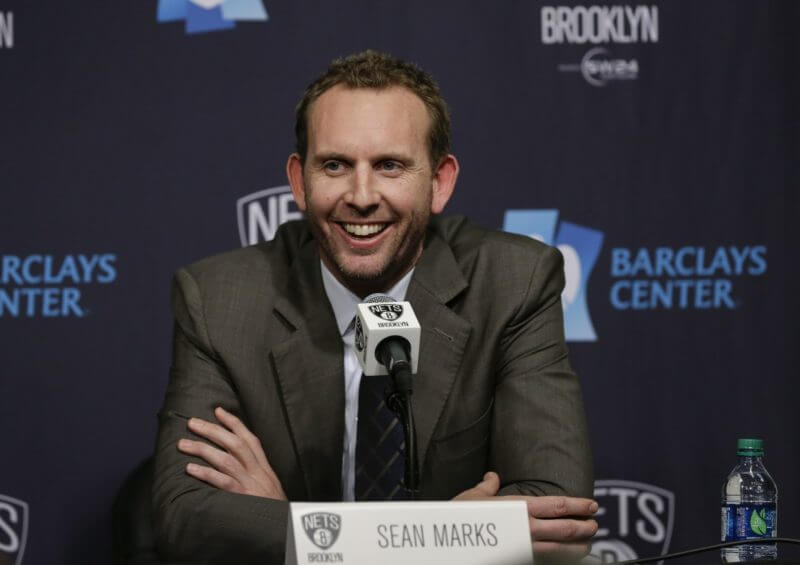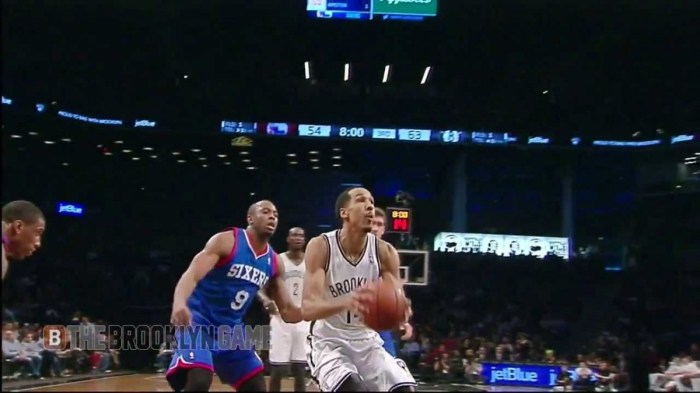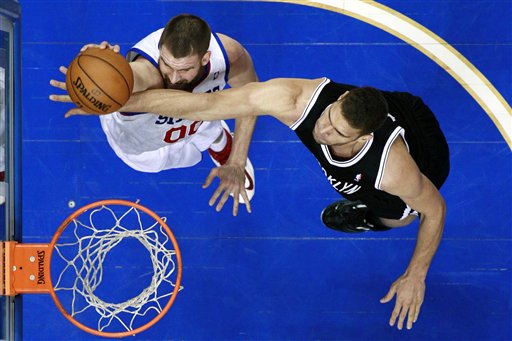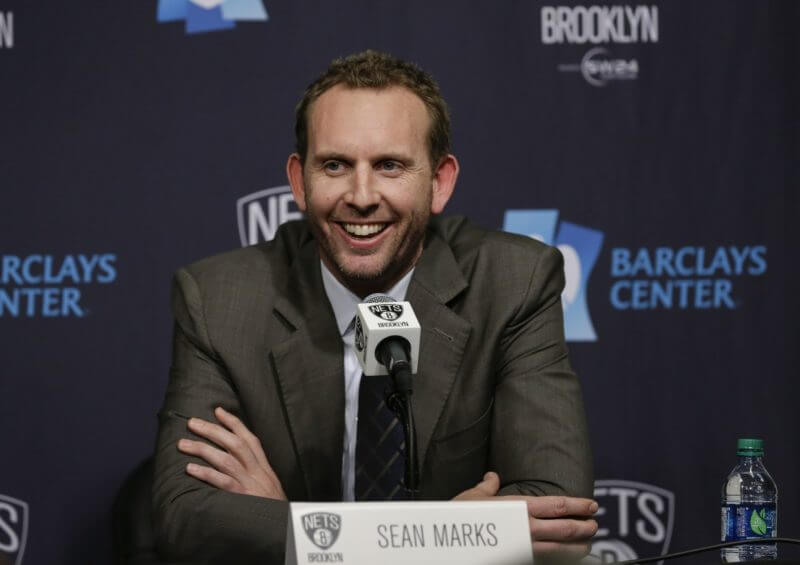
Sean Marks: The First 367 Days
Almost one year ago today — February 18th, 2016 — Sean Marks was hired as the Brooklyn Nets’ next general manager. With the Nets, Marks inherited a franchise with possibly the bleakest future in the entire NBA, suffering a draining of assets rarely seen in professional sports. With no draft picks, no superstars, and no elite prospects, many were skeptical of how Marks would approach the uphill battle of rehabilitating the forlorn Nets.
The previous regime aimed for success in the short term, going all in for a championship as soon as the Nets made the jump to Brooklyn. That strategy yielded only a single playoff series victory — Paul Pierce’s epic Game 7-winning block against the Toronto Raptors in 2014. Marks beat out other high profile general manager candidates in Gersson Rosas, Arturas Karnisovas, and Bryan Colangelo — but hand-picked from the San Antonio Spurs’ managerial tree, he was a home run candidate with high praise from Gregg Popovich and R.C. Buford.
According to Adrian Wojnarowski, Marks was being groomed to take a significant role in the Spurs’ organization before his hiring in Brooklyn. In Marks, the Nets’ upper management saw a leader that would not only change the on-court product but the entire organization from the top down.
Even with all the high praise from NBA luminaries ranging from Zach Lowe to the aforementioned Buford, the Nets haven’t seen much success yet. During the offseason, the Nets lost out on signing the services of restricted free agents of Tyler Johnson and Allen Crabbe, with many others uninterested in the Nets’ advances.
This season itself has been marred with disappointment as the Nets are the worst team in the NBA, by far. Injuries and inconsistent play have compounded an already talent-deficient team — but still, the vibe around the Nets is surprisingly positive. Observers around the league, from journalists to front office executives, respect Marks and the program he’s growing in Brooklyn.
In his first year, here’s what we’ve learned about Sean Marks, his strategy for the future, and his style of leadership.
Culture is Crucial
“Culture” was the buzzword used by the team and media when Marks was first hired and, one year later, it still rings true. In interviews, Marks discussed how the organizational culture was a key factor in the cohesion and continued success in San Antonio. With Brooklyn, Marks stated his desire to build a strong foundation, a culture that reached far beyond the 48 minutes of regulation.
In Philadelphia, some of the criticism former general manager Sam Hinkie received was due to his treatment of players, using them as commodities, just pieces in his plan to acquire a superstar. He filled the team with unknowns without a solid player foundation. While the perception on Hinkie has changed with the emergence of “The Process” — both the player and the plan — this season, the positive “culture” was non-existent for several seasons. Hinkie was tight-lipped with the media and openly defiant when asked about the perpetual losing of the franchise.
It ultimately led to league intervention and his subsequent resignation.
While the losses have piled up in bunches, these players on the roster compete hard every single game. It may be a broken record seeing the Nets start the game cold and then mount an exciting, yet unsuccessful comeback. But the resilience or, more appropriately, #BrooklynGrit can be commended. The competitiveness of the Nets’ players is a positive takeaway from this season, even with the ultimate disappointment in the win-loss column.
The Nets’ 2015 playoff series against the Atlanta Hawks was a bitter example of the Nets’ previous “culture.” At halftime of Game 6, with the Hawks leading the series 3-2, the score was 51-45, the were trailing but not by an insurmountable number. Just a few minutes into the season-defining half, the Nets quit after two bad possessions. It could be seen in the body language of the veterans, lazily throwing passes and moving without conviction. This led to careless Net turnovers and easy baskets for Atlanta, indicating clearly that the series was over with 10 minutes left in the third quarter.
Compare that scene to this season, where the team is vastly less talented, yet is more competitive than in previous campaigns — a reflection of the players and the coaches. Kenny Atkinson, in post-game interviews, speaks highly of his players, outlining their positive play even after a loss. The players on the bench seem genuinely excited and interested whenever a teammate does something — either good or bad. Trevor Booker dances, Joe Harris waves his hands, and Jeremy Lin stands up on every basket, hamstring be damned. The players don’t sulk or look miserable as in previous years, even with the adversity they face. Even though the effort has not translated to wins, the foundation of a winning culture is slowly being established.
Calculated Risks
Without draft picks, Sean Marks has to take risks in acquiring talent. He stated the following in his introductory press conference this season on the lack of picks…
“Sure, draft picks are one way to build a team. But there’s several other places and other ways to go out there and do it. Obviously, you can commit to free agency. My staff, where I’ve learned, I’ve seen it done around the NBA where you’re building not only through free agency, you’re building through the European market, you’re building within your D-League franchise, and developing players there. So, yes, for sure, not having a draft pick as we stand right now — but that, too, can change.”
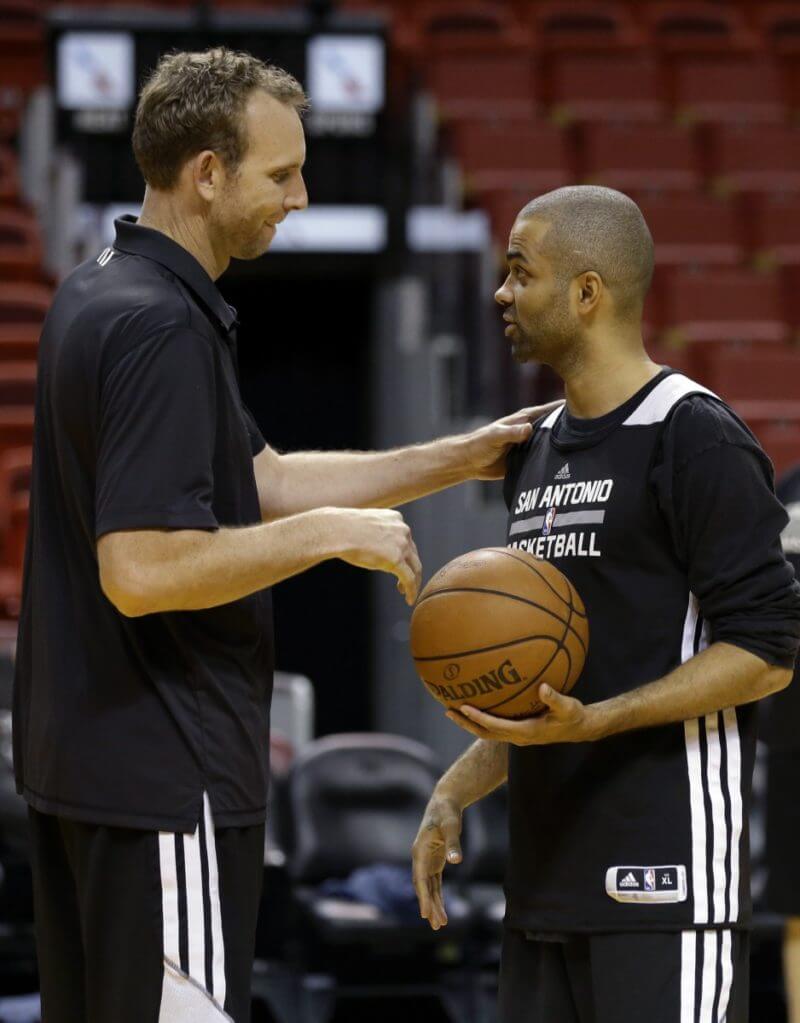
Yet, the risks he’s taken seem calculated and well researched. In the offseason, Marks acquired three players coming off of foot surgery: Greivis Vasquez, Joe Harris, and Caris LeVert. While the Vasquez gamble may not have paid off, Harris and LeVert have played well so far and look to be pieces for the future. The risks Marks took in acquiring those three shows a trust in the medical staff and his scouts. Harris barely played for the Cavaliers, where assistant general manager Trajan Langdon and assistant coach Mike Batiste noticed him, and LeVert was a projected second round pick, yet they have been bright spots with their play so far.
The RFA offers were indicative of the risks Marks needed to make. Crabbe and Johnson were offered $70 million and $50 million respectively, yet were mostly unproven as NBA starters. Rather than pursuing solid veteran free agents like Evan Turner, Gerald Henderson, or D.J. Augustin, the RFAs the Nets signed could have been considered “high risk, high reward” assets. The same could be said for the flirtation of Donatas Motiejunas and the signing, development, and ultimate failure of Anthony Bennett. While those risks may not have paid off, Marks will continue to strategically take calculated gambles.
Family Over Everything
One minor but telling part of the Nets’ recent press conferences has been the language Marks used to introduce people. When Atkinson was introduced as head coach, Marks said: “We want to welcome Kenny and all of his family to the Brooklyn Nets.” In the free agent introductory press conference, Marks added: “We want to welcome Joe, Jeremy, Trevor, Anthony, Justin, Caris and their families to the Brooklyn Nets.” It’s a key detail adapted from the Spurs and an aspect important to Marks himself. He even states the importance and role of his kids and family in a video from his time on the New Orleans Hornets.
In Tim Duncan’s retirement ceremony earlier this season, Tony Parker, Manu Ginobili, R.C. Buford and Gregg Popovich frequently mentioned family in their tributes, not only referring to Duncan’s family but the Spurs’ organization as a whole. Popovich spoke with Duncan’s mother and sister and to Parker and Ginobili, Duncan was like an older brother. Buford saw Duncan as a consummate family man and it was heart-warming to see Popovich, notoriously gruff, speak about how he brought carrot cake to Duncan’s hotel room before every away game — not because Tim requested it, but because the coach cared.
The continuity and family-focused management principles of the San Antonio Spurs is part of the “culture” the Nets aspire to build. In a podcast interview with Yahoo’s Adrian Wojnarowski, Marks said,
“Family is number one. Over the course of a summer or maybe a season, (the players) will realize it’s all about your family… little things along the way that I think will help our players. You know, it’s a grind of a season so anytime they get to be home with their wives, loved ones, it’s important.”
So far, improvements have been made to better accommodate the Nets players and their families, from a remodeling of the family areas to a closer monitoring of their diets. Marks’ vision entails a player-first mentality. The treatment of players is holistic, reaching down to the nitty-gritty details as Marks is aware the profession reaches far beyond the confines of the practice facility and the arena.
Details, Details, (D-League) Details
The often-neglected part of the Thaddeus Young-Caris LeVert trade was the second round pick included in the deal. While second round picks are usually trade filler, they are crucial for an asset-deprived team like Brooklyn. As a reminder, the Nets will not have their own second round pick until 2020. The Pacers’ pick has an interesting protection, protected 45-60 until 2022. The pick is essentially reverse lottery protected, only being conveyed if the Pacers miss the playoffs. While a minor detail on the day of the trade, it may have some important implications. If the Pacers wanted to trade another second round pick before 2022, they would need to compensate the Nets.
The same attention to detail was seen in the Johnson and Motiejunas offer sheets. The Johnson offer sheet was signed under the Arenas provision and, because Miami matched, they will pay Johnson $20 million for the final two years of his deal, a high number under any salary cap. If Miami did not match, Brooklyn would have paid $12.5 million over four years. The Johnson contract also includes a trade kicker, making a potential trade for Johnson even more difficult to manage.
Similarly, the signing of Motiejunas was done with crucial timing and guarantees. Motiejunas signed on December 2nd, past the deadline for players to be traded in-season. Additionally, Motiejunas’ second-year salary would become fully guaranteed by March 1st. If the Rockets decided to not pick up Motiejunas’ second year, they would have paid him $7 million for less than 20 games. The contract essentially forced the Rockets to make a costly two-year commitment to Motiejunas, a player Daryl Morey would have likely dealt for another asset.
Yes, the Motiejunas and Johnson (and Crabbe) offers left the Nets empty handed, but it gave clarity to the detail of the Nets’ cap machinations and contract manipulation. With another year of cap space, it will be interesting to see the creativity of the front office with this summer’s free agents.
The Nets’ D-League affiliate, the Long Island Nets, has been a ground for experimentation. This season, Chris McCullough has pulled double duty, Yogi Ferrell broke out, and the roster has been a carousel. Yes, development has still been key for the young Nets, with Egidijus Mockevicius, Trahson Burrell, and Boris Dallo getting the necessary reps to warrant a second look from NBA teams — but that’s not all.
Long Island has also been a place for scouting as well as Langon has acquired talent with upside in R.J. Hunter, Prince Ibeh, and Cliff Alexander. These acquisitions put the Nets at an advantage moving forward and gives the chance to develop and watch these players firsthand. To borrow a classic Atkinson line, the Nets are leaving no stone unturned, using all of their resources to evaluate talent.
Character, Communication, and Chemistry
While Marks has gambled on overlooked talent, he’s also passed on players with perceived attitude issues or me-first mentalities. The negative attitude of a single player can radiate and affect the entire team, no matter what the talent level. A toxic attitude usually spells bad news, no matter what the sport. For an example, look no further than Rajon Rondo a free agent point guard that was reportedly interested in playing for Brooklyn last summer. The Nets passed on Rondo of them, opting to sign high-character veterans instead. While signing those players may have made a difference in the win column, their presence could have caused locker room rifts — as seen, unfortunately, in the Chicago Bulls’ strange situation.
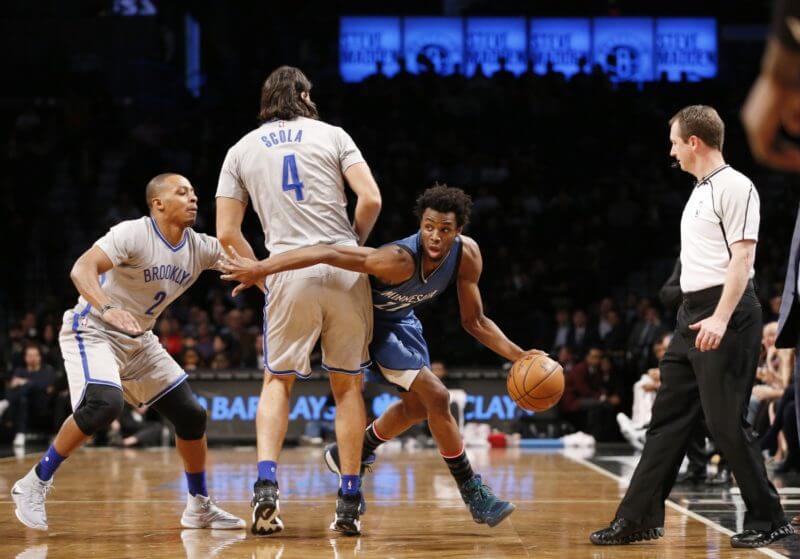 In another interview with Wojnarowski, Marks mentioned targeting “competitive, high character individuals” for the club. The signings of high character veterans like Trevor Booker, Luis Scola, Jeremy Lin, and Randy Foye were praised for being outstanding teammates at previous stops. Foye can often be seen speaking to Isaiah Whitehead on the bench, advising him as he adjusts to the grind of the NBA. Even Greivis Vasquez, while only a Net for less than five games, influenced the young players, noted in Whitehead’s goodbye Instagram. While the on-court production of the veterans may be limited, their contributions, character, and leadership reaches beyond the game film that we’ve compiled way too much of.
In another interview with Wojnarowski, Marks mentioned targeting “competitive, high character individuals” for the club. The signings of high character veterans like Trevor Booker, Luis Scola, Jeremy Lin, and Randy Foye were praised for being outstanding teammates at previous stops. Foye can often be seen speaking to Isaiah Whitehead on the bench, advising him as he adjusts to the grind of the NBA. Even Greivis Vasquez, while only a Net for less than five games, influenced the young players, noted in Whitehead’s goodbye Instagram. While the on-court production of the veterans may be limited, their contributions, character, and leadership reaches beyond the game film that we’ve compiled way too much of.
The presence of coach Atkinson is another sign of the culture and communication that Marks strives for. Aside from being a developmental guru, Atkinson can be considered a player’s coach, working with his roster closely, rather than being a totalitarian. Atkinson can often be seen on the practice court shooting with players. The relationships Atkinson has forged with players throughout his time as an assistant in New York and Atlanta reflect how highly respected he is. Lin, the Nets’ premier free agent signing, has credited most of his success to Atkinson’s belief in his abilities and the latter was key for the point guard to even consider Brooklyn as a free agency destination.
In Atkinson, the Nets found a leader that is focused on both everyday improvements and the long-term outlook. For a team so deficient in assets compared to the rest of the league, the presence of a coach that encourages players to expand their games, rather than limiting them to specific roles, is an underrated aspect of a season that’s been otherwise woefully disappointing.
Where does he go from here?
This season, on paper, has been a disaster. The Nets’ plan to bring in young players backfired and several players have been inconsistent at best. The team has suffered through momentous losing streaks and disappointing breakdowns over and over again. But Marks’ vision still remains the same and managing the Nets was never about giving the Celtics the lowest draft pick possible. Nor was Marks’ plan to allow the young guys to run wild.
“We’re going to do this systematically,” Marks said. “We’ll be doing this strategically and see where our players get made.”
When Marks stepped in as general manager of the Nets 367 days ago, everyone knew that remodeling the franchise was going to be an uphill battle. Marks made it clear that his vision for the Nets required patience as they were essentially starting a new franchise. Marks’ first moves completely revamped the front office and the roster, hiring young, innovative minds and signing high-character talent. Although it isn’t exactly “The Process,” the Brooklyn Nets’ development, ideally, is an improvement that occurs incrementally every day.
There may be setbacks and hardship along the way, but the foundation of a winning franchise is being built, down to the tiniest of details.
The future is open wide and Marks will get the Nets there one way or another.

